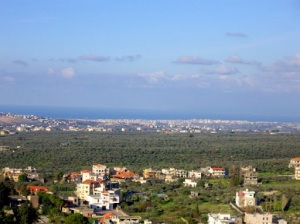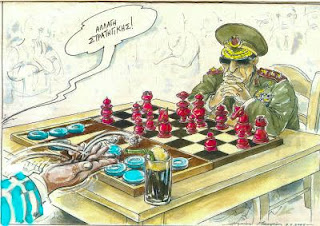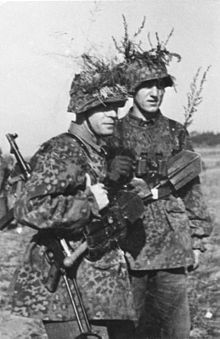SS Panzergrenadier Brigade 49 was a formation of the
Waffen SS during
World War II. It was created in June 1944, from units stationed at the
NCO's (SS-Unterführerschulen) and replacement units. By the end of August it had been virtually destroyed and the remnants were incorporated into the
17th SS Panzergrenadier Division
[edit] Formation
The SS Panzergrenadier Brigade 49 can trace its origins to the SS
Kampfgruppe 1 which was formed in March 1944, from personnel stationed at the NCO'S in
Lauenburg (
Pomerania) and
Radolfzell and the SS Panzergrenadier Training and Replacement Battalion 9 at
Stralsund. They were placed under the command of
Sturmbannfuehrer (Major)
Markus Faulhaber. Until the
Normandy Landings 6 June 1944, the Brigade was just a paper formation, but it had been arranged that the Brigade could be fully mobilized within 48 hours if required.
[1][2]
SS Kampfgruppe 1 was officially renamed the SS Panzergrenadier Brigade 49 on 18 June 1944.
[1][3] The Brigade's title is misleading as the Brigade was an Infantry formation and did not have an armoured unit attached.
[edit] Denmark
The Brigade was activated after the
Normandy Landings and moved to
Denmark from the 11 to the 13 June 1944, this allowed the garrison of Denmark to move towards the invasion beaches, the main formation released was the
363rd Infantry Division. Their secondary task in Denmark was to guard against a suspected Allied landing on the
North Sea coastline. The Brigade was located at the southern end of the
Jutland peninsula
[3][4] and responsible for the defence of the coast between
Bramming and
Ballum.
[5] They were the only major unit between the south of Denmark and the German border, leaving it very open to attack after the departure of the 363rd Division.
[5] A few days later their sister brigade arrived the
SS Panzergrenadier Brigade 51 which relieved the pressure on SS Brigade 49 and allowed the forces to consolidate their positions.
[edit] France
On the 12 August with the German
7th Army being surrounded in
Normandy the Brigade received orders to prepare for an immediate move. The next day they boarded trains for France, their original destination was to be
Calais. In an attempt at
deception they were upgraded and referred to as the 26th SS Panzer Division.
[6]
The Brigade's transfer to France was not without incident with the
Danish Resistance carrying out acts of
sabotage on the rail network and as they got closer to the front the rail cars were attacked by fighter bombers.
[7] The Brigade reached the French coast North of Calais on 16 August.
[8]
They were soon moved again to the area south of
Paris, to try and restore the front line after the American break out of Normandy. By 22 August they were in positions around
Meaux to the east of Paris.
[8]
The Brigade was ordered to establish two bridgeheads across the
Seine river at
Bray and
Nogent each defended by a battalion with a battalion in reserve.
[8]
On the afternoon of 25 August the neighbouring
48th Infantry Division which was covering a bridgehead at
Romilly retreated after encounters with the
U.S. 5th Infantry Division. To cover this gap in the line elements of the I Battalion were sent from Nogent to guard the bridge at Romilly, both bridges were now guarded by reinforced companies.
[8]
The following day the Brigade was attacked by the U.S. 5th Infantry Division, which overran the Brigade headquarters and outflanked the III Battalion which was forced to withdraw. The bridgeheads at Bray and Romilly were also abandoned, while the bridgehead at Nogent was under attack from the
U.S. 7th Armored Division which was driven off. After holding out all day the III Battalion withdrew that night.
[8]
On 27 August the Brigade found a gap in the American line and withdrew to
Sézanne and then on to
Châlons-sur-Marne, where it defeated an attack by the
U.S. 80th Infantry Division, but under pressure from the U.S. 4th Armored, was forced to fall back towards
Verdun.
[8]
At Verdun the brigade found itself the last unit defending the city and managed to hold out against the U.S. 4th Armored for a few days until 31 August.
It then pulled back towards
Metz the following day fighting the advancing American forces enroute.
[8]
[edit] Disbandment
Upon reaching Metz it was relieved by the Metz garrison on 2 September and because of shortages and a lack of manpower, was absorbed into the
17th SS Panzergrenadier Division the next day. The I Battalion and parts of the SS Panzergrenadier Brigade 51 were combined as the II Battalion of the SS Panzergrenadier Regiment 37 and II and III Battalions became the II and III Battalions of the SS Panzergrenadier Regiment 38. What was left of the SS-Junkerschule instructors and equipment, together with the artillery battalion returned to the SS Artillery School II in
Bohemia Moravia.
[8]
[edit] Order of battle
- Commander SS Stubannfuhrer Faulhaber
- I/Battalion SS Panzergrenadier Brigade 49
- II/Battalion SS Panzergrenadier Brigade 49
- III/Battalion SS Panzergrenadier Brigade 49
- SS Artillery Battalion 49
- Headquarters Company
- 13. Infantry Gun Company
- 14. Flak Company
- 15. Pionier Company
- Transport Company
[edit] References
- Landwehr Richard, Alarm Units! SS Panzergrenadier Brigades 49 and 51,Published by Merriam Press, ISBN 576381781
 Επιμελείται ο ΑΠΕΛΛΗΣ
Επιμελείται ο ΑΠΕΛΛΗΣ






